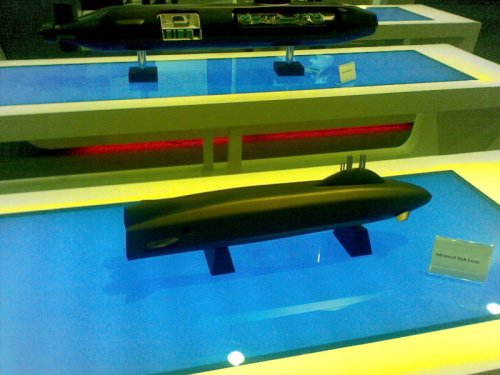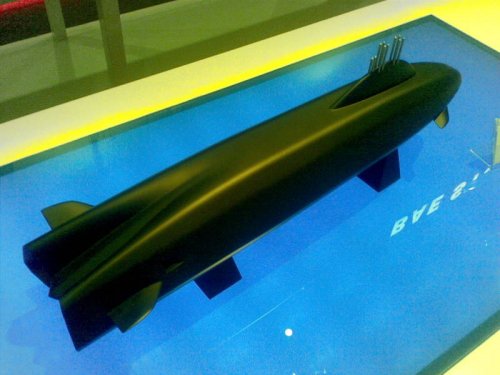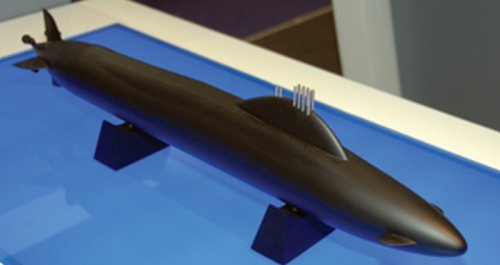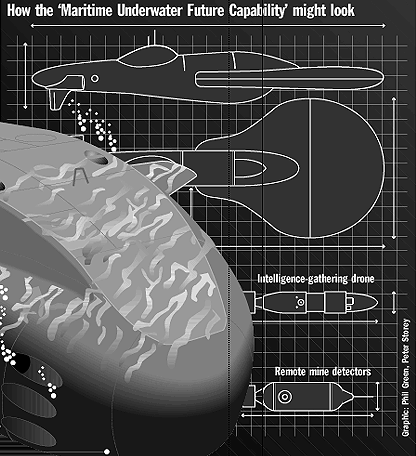Nuclear options
12 January 2009
http://www.theengineer.co.uk/in-depth/nuclear-options/309538.article
Engineers hope that the Astute project will provide valuable lessons for the sub that will carry the UK’s Trident deterrent. Stuart Nathan reports.
The Devonshire Dock Hall, cavernous centrepiece of BAE Systems’ Barrow-in-Furness shipyard, is a noisy place. There’s a constant whine and rattle of machinery and the unceasing back-and-forth of factory vehicles. By the sea doors at the end of the hall sit the focus of much of this activity: two Astute class submarines, the Astute and the Ambush, each almost 100m long, and swarming with engineers.
Production manager Keith Flatman points out the propulsor unit on the stern of the Astute, a large truncated cone-shape with the narrow end pointing backwards. ‘You’ll notice that it’s wrapped up in plastic,’ he says. ‘That’s because we’ve got some Americans knocking around. Our propulsors are better than theirs, and we don’t want them getting any ideas.’
It’s an example of the pride that you see all around the shipyard. There isn’t a huge amount of shipbuilding going on in Britain these days, but it still dominates this small Cumbrian town, with the Dock Hall overshadowing everything else around. It could be said that making submarines is a business with no real competition, but the feeling you get walking around the BAE site is that people are competing: with their own performance, with their previous designs and, of course, with the Americans.
‘American submarines are a nasty green colour on the inside,’ Flatman opined. ‘Our boats are nicer. And faster. And quieter. And sexier.’
Barrow is certainly a hive of activity. The shop floors are stacked with two-inch-thick sheets of submarine steel and the huge rings and domes that make up the hulls of the submarines; in the dock hall itself, four of the eventual seven-strong Astute class fleet are in various states of assembly.
But the activity isn’t confined to the Astute programme. Meeting rooms are crammed with people huddled around laptops, and the gentle blue glow of hundreds of display screens illuminates the faces of the design department, giving their large open-plan office its nickname of the Blue Lagoon.
And while the heavy work of shipbuilding goes on around the site, these engineers have their eyes on Barrow’s next project: the successor to the Vanguard class submarines, which carry Britain’s Trident nuclear missiles.
The as-yet unnamed submarine class, simply referred to as Successor, is a long-term project: the first of the new boats is not expected to enter service before approximately 2017. However, BAE and its partners in submarine projects, Rolls-Royce (which provides the nuclear power plants and propulsion systems for the submarines) and Babcock Marine, which maintains and services submarines for the Royal Navy, have been working on the project for some time, and the design process is well advanced.
There are two strands to the process — one, to design the submarine itself, including the development of new technological features to ensure that the boat can fulfil its allotted role; the other, to work out the most efficient and cost-effective ways to build the submarine to accommodate budget squeezes and ensure that the taxpayers’ money is well spent. In the latter, various departments around BAE are looking closely at how the Astute class submarines are being built, and seeing where the engineering practices can be finessed, tweaked and in some cases redesigned altogether to make every penny of the budget count.
The company is unsurprisingly tight-lipped on the specifics of the engineering and technology; deterrent submarines are, after all, the most secret and stealthy of machines. But there are some clues as to what might be in store.
The most striking of these are two models that were displayed at the DSEi (Defence Systems and Equipment International) exhibition in 2007. Dubbed ‘Concept 35’ and ‘Advanced Hull Form’ (AHF), they represent a conservative and radical view, respectively, of how a future deterrent submarine might look and work.
Concept 35 was developed as an evolution of the current Vanguard class submarines, with a similar design philosophy to that of the Astute class: drive down costs throughout the boat’s lifetime, wherever possible. This included using off-the-shelf components wherever possible, rather than investing in custom design; examples include replacing the low-pressure air blower, which is used to flush fume-filled air from the submarine and to fill ballast tanks, with a compressor system developed for blowing grain into silos. ‘We’ve found that it’s a smaller product, it’s quieter, and it’s a lower cost solution than making our own component, because we’re buying from a company that’s made its own investment in R&D, rather than having to spend that money ourselves,’ said Kevin Young, in charge of design improvement at Barrow.
But some aspects of the Concept 35 design are less conservative. For example, industrial automation techniques are used to a far greater degree for submarine control and condition monitoring. The nuclear power plant, like next-generation civil reactors, incorporates passive safety features (such as coolant valves that will automatically open if they fail, rather than close, so that coolant can still reach the reactor core). Control surfaces are actuated electrically rather than hydraulically, and some weapons systems are mounted outside the hull. Most striking in mechanical terms is that the drive system is all-electric and shaftless, with the propulsor unit operated by electric motors. Such a system is under active consideration by BAE, Rolls-Royce and Babcock, said BAE Submarine Systems chief engineer John Hudson, although he pointed out that there are technical pros and cons of both all-electric and all-mechanical drives.
The AHF design is clearly very different from any submarine in the oceans. Oval in cross-section rather than cylindrical, the hull splits into a Y-shape at the stern with the propulsors mounted inside angular-shaped ducts that are integrated into the hull itself, rather than being mounted on the stern. The hull form is made from flat or singly-curved surfaces, which would reduce the cost of building the submarine: double-curved surfaces, such as the domes at either end of a conventional submarine, are the most expensive part of the hull. The hull shape, which was designed using hydrodynamic modelling techniques, is also claimed to be more manoeuvrable than a conventional submarine, and would also make it easier to mount recovery operations in case of an emergency.
Like the Concept 35, the AHF is designed so that much of the payload and equipment can be mounted outside the pressure hull. This both increases space available inside the boat — which is constantly at a premium, making cruises even more arduous for the submariners — and makes the submarine safer, because it reduces the number of times the hull has to be penetrated to link internal systems to the outside. The periscope of the Astute class epitomises this approach — rather than using a tube from the top of the sail down to the bridge desk, the periscope is a video camera outside the pressure hull that relays images down to the commander.
With the current emphasis on cost-cutting, it might seem likely that Successor will resemble Concept 35 rather than AHF; in fact, a ‘stretched’ version of the Astute may be under consideration, with a section containing the nuclear missile launch tubes inserted behind the sail. Even so, this does not mean that the new submarine will resemble the Astute, which was itself evolved from the older Trafalgar class hunter/killers subs, but is now very different.
Other clues to new technology can be found from BAE’s research collaborations, particularly at the company’s Centre for Research in Active Control at Sheffield University. Established in 2007 and the recipient of a £1.4m grant from the firm, the centre is looking at various methods for making submarines quieter — an ability that is vital for the hide-and-lurk role of a deterrent submarine.
The centre, under director Professor Steve Daley, is looking at ways to reduce the effect that vibrating machinery has on the acoustic signature of the submarine, using a number of methods to prevent the vibration from reaching the hull and generating a sound wave that could betray the submarine’s location. Daley’s team has developed a system called selective damping that uses ‘electrodynamic shakers’ — devices somewhat like a loudspeaker that generate a vibration exactly out of phase with, and therefore cancels out, the shaking of the machinery. This can be applied at the site itself and remotely, with accelerometers measuring the frequency and waveform of the machine vibration and transmitting that back to a control system, which calculates a cancelling signal and operates shakers on the parts of the vessel connected to the vibrating equipment. This is particularly useful with inaccessible parts of the submarine, such as the impeller, where it is difficult to measure vibration.
Another project aims to develop a ‘smart spring’ mount that will directly isolate vibrating machinery from its surroundings. This is developed from passive systems, where small machines that emit high-frequency vibration are mounted on blocks of rubber, but this solution does not work for low-frequency noise and large machinery. Instead, the researchers are combining this passive damping with an active system that will work together with sensors throughout the submarine, to damp vibration at the source and prevent it from being transmitted throughout the vessel.
But incorporating innovative design and new technology is of no use if the construction process is inefficient, as this can lead to time overruns and problems that can take the project far over-budget. In a small office in Barrow whose walls seem to be covered with several layers of complex charts, plans and diagrams, Alan Stokes, an engineering manager, is working on how to organise the engineering processes involved in this major project. ‘We engineers are actually pretty organised people, but it takes us a while to get organised, and the schedule can get hurt in that time. We’re trying to make sure that when engineers are put onto the job, they can get on with it; that involves a lot of planning ahead, which can be difficult, because often you don’t know all the variables.’
Many of the refinements that Stokes is piloting seem simple; for example, listing as many components that are needed for a particular system first in general terms, then in more specific terms of their actual requirements, and finally specifying the exact component. ‘For example, you might know that a system you’re working on will need a water pump. At first, you won’t know how powerful that will have to be, but “pump” will go on the list anyway. As you progress through the project, you’ll decide more about the requirements for the pump, and update the list. But this means that all the way through everyone will know that you need to specify a pump, and if it isn’t specified and costed, it’ll be easy to see that there’s still a gap in the budget.’
This type of planning requires a degree of co-operation between design, engineering, purchasing and other departments, which hadn’t existed before, Stokes said. ‘Making these sorts of detailed plans early on doesn’t add much to the cost of the project, but if you don’t make the plans, it can end up costing you a lot of time and money.’
Out on the floor of the Dock Hall, Keith Flatman explained how new production techniques that have been piloted on the Astute project will also reduce costs on Successor. Some of these have been modelled on those used by the American submarine manufacturer Electric Boat, where each section of the submarine hull is placed vertically and the various components are lowered into it and welded into place, before the whole section is turned sideways to be attached to the sections behind and in front of it.
Others have been taken from the automotive sector, such as assigning each section of the submarine its own work gantry, complete with tool shop, design office and working platforms. This, Flatman said, ensures that the engineers working on a section always have close access to tools, plans and supervisors. Other practices include making sure that components are delivered to the Dock Hall in the correct condition that is needed for them to be installed.
‘Really, it’s quite a simple job,’ he commented. ‘We stick that bit’ — indicating a towering cylinder of steel — ‘to that bit’ — pointing at the stern end section of the Artful, one of the subs under construction — ‘and then we chuck ‘em in the water. Those are shipbuilding terms, you know. But if we talk to each other, and make sure that everyone can get on with the jobs they’re supposed to be doing, we can do it faster and more effectively. And that’s how we get these things done.’
Read more: http://www.theengineer.co.uk/in-depth/nuclear-options/309538.article#ixzz1dLhsOplF





![[(1630)-27-09-2001]Future%20ship.jpg](/data/attachments/9/9451-a9cde3ee286f07f8c3c4526d4ef6ca4a.jpg)
![[(1523)-25-09-2001]engine.jpg](/data/attachments/9/9452-0ec009180af6cd236b0f55cdadd134a6.jpg)
![[(1524)-25-09-2001]sonar.jpg](/data/attachments/9/9453-27380b8bd7f4922f64d6a4f48aaf8740.jpg)











